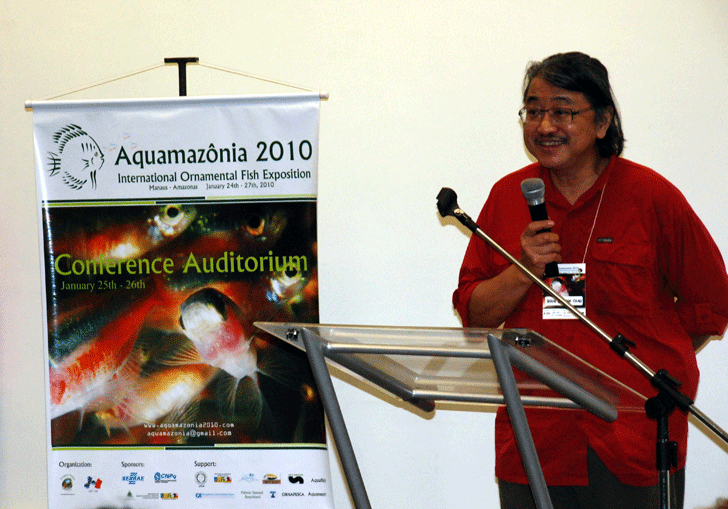Fishing Aquamazonia Conference

Earlier this year a landmark
event was conducted in Manaus, Brazil from January 24-27 called Aquamazonia
and from all reports and the need, the event will continue.
Aquamazonia in its inaugural year was
the first time ever that brought together the international ornamental
fish and accessory industry in the heart of Amazon; the origin of wild-caught
Amazon fishes that have such a prominent place in aquariums worldwide.
The theme of Aquamazonia was to advance
the industry towards a green, environmentally and socio-economically
responsible business.
“We had a success with just over
100 registered participants,” said Professor Ning Labbish Chao
who organized the event.
Professor Chao who has been active in
the Amazon for the past 25 years is director of Project Piaba that sponsored
Aquamazonia.
Project Piaba is community-based and interdisciplinary
established to understand the ecological and socio-cultural systems
of the middle Rio Negro basin, Amazonas, Brazil, in order to conserve
and maintain the live ornamental fishery and other renewable resources
at a commercially feasible, and ecologically sustainable level.
“Our technical conference with European,
North American and Asian industry leaders and stakeholders, and of course
Brazilian government support was very useful.
“We identified several bottlenecks
with air transportation from Manaus.
“Firstly costs are prohibitive with
much higher transport prices from that gateway.
“Also in most cases live fish have
not been given special attention at the hangar, despite dramatic temperature
variations that our people have found.
“Consensus amongst many shippers
here is that live fish are treated as secondary cargo by most transporters
often with unannounced delays and cancellations of flights.
“As to what lies ahead for our intiative
at present, we are going ahead to work on a Green Trade Chain through
local fish collectors, COOP and a couple of small exporter and importers.
 “The
“Green Fish” idea has probably more appeal to the EU than
to the Asian market now. “The
“Green Fish” idea has probably more appeal to the EU than
to the Asian market now.
“Our January event in Manaus was
a starting point.
“As an advocate of the Green ornamental
fish industry, I hope this event can be rotated among Amazon ornamental
fish exporting countries.
“The Colombia Association of Ornamental
Fish is interested in hosting our next event in 2012.
“Right now at Projeto Piaba, we
are advancing geographic certification to differentiate Rio Negro ornamental
fish from captive bred ones.
“In Brazil a lot of bureaucratic
and local issues need to be solved.
“As example, as we speak today,
Sunday April 11, the Brazilian environmental agency IBAMA is on strike
and all ornamental fish exports have been shut down.
“So our attempts are constantly
challenged.”
By way of background, Project Piaba works
to conserve and maintain the live ornamental fishery and other renewable
resources at a commercially feasible, and ecologically sustainable level.
The Amazon River basin drains an area
of 7.5 million km2 and includes within its catchment: Bolivia, Brazil,
Colombia, Ecuador, French Guyana, Guyana, Suriname, Peru and Venezuela.
It is the largest river in the world and
drains 20% of all the world's freshwater into the ocean.
Amazon tributaries have their origin in
the high Andes, Guyana, and Brazilian highlands; endowing the river
water with its white, green, clear, and black colors. The largest tributary
is the Rio Negro; other major tributaries include Rio Branco, Japura,
Madeira, PUNS, Tapajos, Tocantins, Trombetas, Xingu, etc.
These river systems are the home to over
3,000 species of fishes; many of which have ornamental value for home
aquarium and public aquarium exhibition.
Amazon countries contribute about 10%
of the freshwater ornamental fish trade; Brazil, Colombia and Peru are
the major exporters.
The wild-caught Amazon ornamental fisheries
are strongly tied to livelihood of rural people and the well being of
the rainforest ecosystem.
Fish collectors live in remote villages;
ornamental fishes have provided a livelihood for tens of thousands of
these rural people, or caboc/os, for over 50 years.
Ornamental fish as a non-timber forest
product have greatly benefited the Rio Negro basin; the fish trade has
kept deforestation, wildlife poaching, and socio-economic strife to
a minimum. “What Aquamaozia wanted to bring forward most of all,”
says Professor Chao, “is that governments and the industry should
realize that to maintain a viable wild caught ornamental fishery requires
a very small investment that can bring a great reward: the conservation
of Amazon rainforest.
“Therefore, "Buy a Fish, Save
a Tree" is our cry to the industry.
During the Aquamazonia Exhibition and
Conference exhibitors and conferees were able to connect with fish suppliers
of the Amazon region and open markets for new products.
Aquamazonia as mentioned at the top included
technical and trade discussions meant to promote regional cooperation
and dialogue among stakeholders and decision makers.
There were fish farm visits and field
trips to the ornamental fish capital, Barcelos, Rio Negro.
The field trip included visiting collecting
sites, meeting the fisher folk, and observing the chain of custody of
Amazon fishes from collectors, intermediate buyers, holding facilities,
and finally to transports.
But since this was a conference in Brazil—it
was not all just work.
In Barcelos for example conferees joined
the annual Ornamental Fish Festival and beach parties coincidentally
held every year at the end of January 2010.
More Prof. Chaio: piabachao@gmail.com,
also piabas@aim.com.
Website: http://www.opefe.com/piaba.html
Geoffrey |






